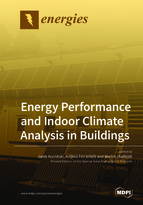Energy Performance and Indoor Climate Analysis in Buildings
A special issue of Energies (ISSN 1996-1073). This special issue belongs to the section "G: Energy and Buildings".
Deadline for manuscript submissions: closed (30 April 2019) | Viewed by 69553
Special Issue Editors
Interests: energy performance; indoor climate; zero energy buildings; HVAC systems; building simulation
Special Issues, Collections and Topics in MDPI journals
Interests: building physics and energy efficiency
Special Issues, Collections and Topics in MDPI journals
Interests: heat transfer; theoretical modelling; building simulation; energy performance; thermal comfort
Special Issues, Collections and Topics in MDPI journals
Special Issue Information
Dear Colleagues,
This Special Issue is dedicated to energy performance, HVAC and other technical systems, and indoor climate analyses in buildings. Articles dealing with new, low energy and nearly zero energy buildings (NZEB) are especially welcomed. On the background of this issue are NZEB requirements recently established and soon taken into use in all EU Member States, as well as similar developments in Japan, US and other countries. NZEB definitions, system boundaries, performance levels and energy calculation input data show no consensus at a European level, indicating a need for benchmarking for future harmonization in the common market. Therefore, it is difficult to understand which countries have set stringent requirements leading to best possible energy performances. Climate differences provide an additional challenge. Revised EPBD directives stress that specification of adequate ventilation and comfort levels is the responsibility of Member States, which calls for comparative analyses how indoor environmental quality (IEQ) criteria is set nationally and how good IEQ is achieved in practice in new high performance buildings. Benchmarking, assessment of technical solutions needed for NZEB, performance analyses and energy flexibility measures in the context of new smart readiness indicators are some examples of topics that are welcome in this Special Issue.
Prof. Dr. Jarek Kurnitski
Dr. Martin Thalfeldt
Dr. Andrea Ferrantelli
Guest Editors
Manuscript Submission Information
Manuscripts should be submitted online at www.mdpi.com by registering and logging in to this website. Once you are registered, click here to go to the submission form. Manuscripts can be submitted until the deadline. All submissions that pass pre-check are peer-reviewed. Accepted papers will be published continuously in the journal (as soon as accepted) and will be listed together on the special issue website. Research articles, review articles as well as short communications are invited. For planned papers, a title and short abstract (about 100 words) can be sent to the Editorial Office for announcement on this website.
Submitted manuscripts should not have been published previously, nor be under consideration for publication elsewhere (except conference proceedings papers). All manuscripts are thoroughly refereed through a single-blind peer-review process. A guide for authors and other relevant information for submission of manuscripts is available on the Instructions for Authors page. Energies is an international peer-reviewed open access semimonthly journal published by MDPI.
Please visit the Instructions for Authors page before submitting a manuscript. The Article Processing Charge (APC) for publication in this open access journal is 2600 CHF (Swiss Francs). Submitted papers should be well formatted and use good English. Authors may use MDPI's English editing service prior to publication or during author revisions.
Keywords
- energy performance
- HVAC systems
- indoor climate
- nearly zero energy buildings







